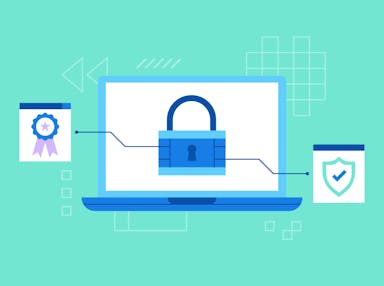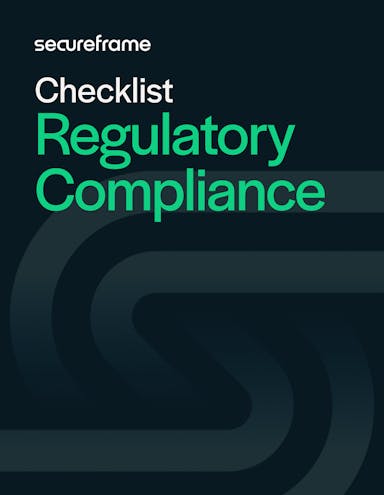
Regulatory Compliance: Benefits and Best Practices to Keep Your Business Safe [+ Checklist]
Anna Fitzgerald
Senior Content Marketing Manager
Rob Gutierrez
Senior Cybersecurity and Compliance Manager, CISA, CCSK, CMMC RP
As an organization, you may have to comply with a range of local, federal, state, and industry regulations.
This is becoming more challenging for organizations as regulations continue to evolve to address the changing threat landscape and growing privacy concerns of consumers. Small businesses and other organizations that lack in-house compliance expertise are most acutely experiencing this pain point.
To help you better understand what regulatory compliance is and how it applies to your organization, we’ll cover the essentials below, including common compliance regulations and best practices.
Regulatory compliance refers to an organization’s adherence to laws, regulations, and guidelines created by governmental and regulatory agencies. These rules vary based on an organization’s industry, location, and sector. Meeting compliance standards is critical to safeguarding your business from legal repercussions and building stakeholder trust.
To ensure regulatory compliance, organizations must:
- Identify all applicable laws and regulations that affect the business
- Discover areas where the organization fails to meet laws and regulations
- Implement controls and procedures to effectively comply with laws and regulations
- Keep up with changes to the laws and regulations that affect their industry and country
Failing to comply with local, federal, state, or industry regulations can lead to significant financial penalties and reputational damage, especially within industries like healthcare, finance, and energy.
Recommended Reading

What Is Compliance Risk and How To Minimize It [+ Free Template]
Why is regulatory compliance important?
Regulatory compliance offers an organization several benefits. Let’s take a look at four of the biggest benefits below.

1. Avoiding fines and penalties
It’s critical to research which regulations and laws apply to your organization based on your location and industry.
For example, if you collect customer data — whether that be credit card information, website cookies, or personal identifiable information (PII) — there are regulations you should adhere to. If you collect data from EU residents, you must comply with GDPR. Europe’s GDPR is known as one of the strictest regulations, with the ICO fining organizations up to €20 million for violations.
The U.S. is also cracking down on compliance, passing several state regulations. Most notable is the California Consumer Privacy Act (CCPA), which has no upper cap on penalties. That means organizations could face potentially enormous fines if they are found to be out of compliance.
Implementing a comprehensive regulatory compliance program can help you avoid fines and penalties.
2. Improving internal processes and procedures
Complying with industry regulations and laws can help organizations create streamlined, scalable internal business processes and procedures.
For example, HIPAA compliance requires organizations to create and implement a set of policies and procedures that ensure individual employees are safely handling PHI in their day-to-day roles. This may include an access management policy, data backup and retention policy, disaster recovery policy, and incident response policy, among others.
Internal processes and procedures like these not only help ensure compliance. They also reduce the risk of data breaches, improve employee retention and engagement, and enhance an organization’s overall security posture.
3. Preventing security breaches
Organizations in any industry that collect and store data can fall victim to a costly attack. Certain industries like healthcare and finance hold particularly sensitive information, and are more vulnerable.
The healthcare sector suffered about 295 breaches, implicating more than 39 million individuals, in the first half of 2023 alone, according to the HHS Office for Civil Rights (OCR) data breach portal.
Strong regulatory compliance measures can deter cyber criminals from attacking your organization and help keep your data safe.
4. Enhancing reputation and trust
A massive security breach can devastate a company’s reputation. For example, the 2022 attack on T-Mobile that exposed the private information of over 77 million people caused significant damage to the brand’s reputation. Not only did the company have to notify affected customers that their data was compromised and pay $350 million to settle multiple class-action lawsuits — the event also made global news and is viewed as a massive cybersecurity failure.
Repairing stakeholder trust after a breach is painstaking work and is not guaranteed. Regulatory compliance must be taken seriously to demonstrate your organization’s commitment to protecting its data and to maintain the trust of vendors, clients, and customers.
5. Driving business growth
Most prospective customers expect their vendors to be compliant with applicable laws and regulations before signing a contract. This is especially true for customers in the financial services, health care, and insurance industries, which hold particularly sensitive information.
Achieving regulatory compliance demonstrates your commitment to keeping your and your customers’ data safe. This can provide a major competitive advantage, help you close more deals faster, and move upmarket.
Regulatory compliance frameworks
Regulatory compliance frameworks provide guidelines for how to handle personal data, patient health information, credit card information, and more. By following these guidelines, organizations can not only meet regulatory requirements — they can also strengthen their security and achieve other business objectives, like accelerating speed to revenue.
Let’s take a look at some of the most common regulatory compliance frameworks to help you decide which are right for your organization.
HIPAA
Who it applies to: The healthcare sector
The Health Insurance Portability and Accountability Act (HIPAA) is a 1996 federal statute that mandates standards for protecting patient health information. All healthcare organizations must follow cybersecurity practices and run risk assessments to comply with HIPAA.
The healthcare sector is the seventh most frequent target of cyberattacks, so organizations within the sector need to be vigilant.
PCI DSS
Who it applies to: Merchants and service providers who store, process, or transmit cardholder data or can impact the security of their customers’ cardholder data.
The Payment Card Industry Data Security Standard (PCI DSS) was created in 2006 to ensure that all companies that accept, process, store, or transmit credit card information operate securely. The framework is primarily intended for consumer protection and keeping cardholder information safe. All financial institutions, retail companies, and other organizations handling this information must comply with PCI DSS, regardless of size.
Unlike government-mandated frameworks, payment brands (MasterCard, Visa, etc.) enforce PCI DSS compliance.
GDPR
Who it applies to: All businesses that collect EU citizens’ data
The European Union passed the General Data Protection Regulation (GDPR) to protect the data of EU citizens. It applies to all businesses that collect and process EU citizens’ data, whether or not those businesses are based in the EU. The framework lists regulations related to consumer data access rights, data protection rights, consent, and more. Compliance is enforced by the Information Commissioner's Office (ICO).
The regulation is extensive — 88 pages, to be exact — and ICO is notorious for heavily fining companies that fail to comply. For example, Amazon was famously fined $880+ million in 2021 for tracking user data without appropriate consent.
CCPA
Who it applies to: Businesses and ad tech companies that manage California residents’ personal data
The California Consumer Privacy Act (CCPA) was passed in 2018 to protect the data privacy and security of California residents. It requires compliance from businesses that collect user information and the ad tech companies that purchase it, even if those organizations aren’t physically located in California or the United States.
It is enforced by the Office of the Attorney General in California.
SOX
Who it applies to: Public companies in the U.S.
The Sarbanes-Oxley Act of 2002 (SOX) is one of the most well-known regulations in the United States. After a string of major accounting scandals eroded investor and public trust in the early 2000s, this regulation established stringent rules for U.S. public companies to document financial compliance and corporate disclosures in order to prevent financial fraud and protect investors and the public.
While privately-held companies and nonprofits do not generally need to comply with SOX, many of the framework requirements are considered best practices for any company to implement.
SOX is enforced by the Securities and Exchange Commission (SEC) and audit rules are overseen by the Public Company Accounting Oversight Board (PCAOB).
FISMA
Who it applies to: The federal government, supporting agencies, and third party contractors operating on its behalf and/or handling federal data
The Federal Information Security Management Act (FISMA) was passed with the goal of better protecting U.S. government assets. It requires the federal government and third parties operating on its behalf to document allassets and network integrations, monitor their IT infrastructure, and regularly evaluate risks.
The Department of Homeland Security is responsible for overseeing its implementation.
FAR
Who it applies to: Executive agencies
The purpose of the Federal Acquisition Regulation (FAR) is to ensure purchasing procedures are standard, consistent, and conducted in a fair and impartial manner and to protect information.
FAR clauses establish basic safeguarding requirements for Federal Contract Information (FCI), and the Defense Federal Acquisition Regulation Supplement (DFARS), which implements and supplements the FAR, establishes security requirements for controlled unclassified information (CUI). These requirements for FCI and CUI are encompassed by CMMC 2.0, which is a derivative of the National Institute of Standards and Technology (NIST) 800-171 that’s specific to DoD contractors and any other organizations providing services involving CUI or FCI to government agencies.
The FAR is prepared, issued, maintained, and prescribed jointly by the Secretary of Defense, the Administrator of General Services, and the Administrator of the National Aeronautics and Space Administration.
FERPA
Who it applies to: Educational agencies and institutions that collect student data
The Family Educational Rights and Privacy Act of 1974 (FERPA) was passed to protect the privacy of student education records. This regulation prohibits institutions from disclosing personally identifiable information in education records in most cases without the written consent of parents or eligible students (students who are 18 years of age or older or attending a school beyond the high school level).
It also gives parents and eligible students more control over their education records. Under FERPA, they have the right to have access to their education records, the right to seek to have the records amended, and the right to have some control over the disclosure of personally identifiable information from those records.
FERPA is administered and enforced by the U.S. Department of Education.
Dodd-Frank Act
Who is applies to: Financial services sector
The Dodd-Frank Wall Street Reform and Consumer Protection Act was signed into law in 2010 in response to the financial crisis of 2007-2008. It aims to prevent the excessive risk-taking and abusive practices that led to that crisis.
The law established the Financial Stability Oversight Council (FSOC) and the Consumer Financial Protection Bureau (CFPB), which oversees financial products and services, including mortgages, credit cards, and student loans. It also imposes more stringent regulations on large banks and financial institutions, including increased capital requirements and supervision. It restricts banks from making certain kinds of speculative investments and requires more transparency and accountability for derivatives markets to reduce risks and prevent market manipulation.
Different aspects of the Dodd-Frank Act are enforced by the CFPB, the SEC, the CFTC, the Federal Reserve, the OCC, and the FDIC.
CJIS
Who it applies to: Government agencies, contractors, and vendors that access or handle criminal justice information (CJI)
The Criminal Justice Information Services (CJIS) Security Policy is a framework established by the FBI to protect the confidentiality, integrity, and availability of criminal justice information (CJI). This policy applies to federal, state, and local government agencies, as well as private contractors and vendors that access, process, or transmit CJI.
Organizations must implement security controls related to access management, data encryption, incident response, auditing, and physical security to comply with CJIS. Compliance is mandatory, and agencies are responsible for ensuring that any third parties they work with also meet CJIS security requirements.
Each state has a CJIS Systems Agency (CSA) responsible for ensuring compliance and conducting audits. Non-compliance can result in losing access to CJI systems, penalties, or contract termination.
Recommended Reading

Essential Guide to Security Frameworks & 14 Examples
Regulatory compliance risk
Regulatory compliance risk is the potential damage businesses face when they fail to comply with laws and industry regulations. There are many reasons to avoid regulatory compliance risks, including reputational, business, financial, and legal implications that can affect your day-to-day business operations.
Reputational
Failing to comply with industry regulations can damage your reputation. A single data breach or exposure due to poor regulatory compliance management can result in a significant blow to your reputation and loss of clients. It may also cost millions in terms of recovery and cleanup, implementing new controls, and recovering customer trust.
Business
Failure to comply with certain industry regulations can lead to fines, business shutdowns, or impact the way you run your business.
For example, non-compliance with the Payment Card Industry Data Security Standard (PCI DSS) could lead to the suspension of your ability to accept major credit cards like Visa and Mastercard. Customers might avoid purchasing from your company or walk away if they do not have another payment type with them.
Financial
The financial impact of regulatory compliance risk can be drastic. Lost investors, property, and overall revenue can result from strikes on your account, breaches, shutdowns, and more.
Financial implications from non-compliance include loss of investors, loss of revenue, and legal fees.
For example, a multi-year investigation by the SEC determined that General Electric misled investors between 2015 and 2017 by failing to disclose the true source of much of its reported profits. GE’s settlement with the SEC included a $200 million penalty for violation of securities laws related to anti-fraud, reporting, disclosure controls, and accounting controls. The disclosure of the fraud also led GE’s stock price to drop by nearly 76%.
Legal
If you fail to comply with industry regulations and best practices, legal action may be brought against your company and/or employees. This can lead to costly fees, penalties, imprisonment, exclusion, or forfeiting products and property.
Failure to comply with SOX, for example, can result in penalties upwards of $5 million in fines and 20 years in prison for corporate executives.
For businesses unable to handle the financial burden, legal issues can often lead to a company shutdown.
Regulatory compliance best practices
It’s clear why regulatory compliance is important — but how exactly to achieve it is not. Below are best practices that can help you build or strengthen your regulatory compliance program.

1. Identify regulations and risks
To start, identify all the regulations and laws that apply to your organization. Consider not just the well-known regulations and compliance standards like HIPAA and PCI DSS, but also state and local regulations. Pinpoint the types of risk your organization faces, such as organizational, reputational, and strategic.
If you lack a chief compliance officer, legal counsel, or in-house experts that can identify and understand which regulations apply to your organization, an automation platform that also offers customer support and compliance expertise can help guide you through that process.
2. Conduct an internal audit
Next, perform an internal audit to assess not only whether your business is meeting the regulations it needs to, but also how effective your existing security and compliance strategy is. With an internal audit, you may determine how many violations your company has had and how much they’ve cost you, for example.
It can also help identify any risks that could result in additional violations and fines. For this reason, internal audits are a key aspect of risk management.
3. Design a compliance plan
Once your organization has a clear picture of the current state of its regulatory compliance strategy and the regulations and risks that shape it, you can begin to draft a plan. This plan should be created among stakeholders from IT, compliance, and upper management and include which regulations you’re expected to comply with and how you plan to achieve compliance.
4. Start with your highest priorities
Rather than try to solve everything at once, consider taking a phased approach. This approach allows an organization to start small and focus on the most important area. Start with the organization’s highest priorities — like complying with a specific law or regulation to reduce a fine or violation — then expand the program. This will help show value faster, and garner continued support from stakeholders.
5. Provide your employees with regulatory compliance training
Achieving and maintaining regulatory compliance is not just one officer’s or team’s responsibility. It’s the responsibility of every member of your workforce.
That’s why it’s essential that your employees are kept up-to-date on the latest industry regulations and security and privacy best practices related to their job and organization. Without this information, they may not understand their responsibility in ensuring regulatory compliance and unknowingly violate laws and regulations that apply to your business.
Providing periodic and up-to-date regulatory compliance training to employees can help avoid compliance issues like these.
6. Create a system for continuous monitoring
Consider yearly or biannual audits and reviews of your regulatory compliance strategy to gauge its effectiveness and make adjustments — if the regulatory frameworks that apply to your organization don’t already require them. As your strategy matures, the processes that guide your organization will become more effective.
7. Use regulatory compliance software
Automating your corporate compliance process with the right tools can help simplify and streamline a lot of the manual work required to comply with regulations, particularly around workflows, reports, and recordkeeping. Automating time-consuming manual compliance tasks such as collecting audit evidence, monitoring control performance, and conducting risk assessments can streamline business processes significantly. This can save tens of thousands of dollars and months of your security and compliance team’s time.
Regulatory compliance checklist
If you’re still unsure of how to implement an effective regulatory compliance management program at your organization, use this checklist to get started.

Download the free Regulatory Compliance Checklist
Use this interactive checklist to guide your regulatory compliance management program, checking off tasks as you progress in your compliance journey.
How to maintain compliance with regulatory requirements
Getting compliant with laws and industry regulations is a significant milestone, but maintaining compliance is an ongoing challenge that is increasingly difficult due to changes in regulations and technology.
All of that work you did to implement, monitor, and document risks and controls, train staff, and document evidence, you’ll have to do again. And again. This work will only increase as your company scales and compliance becomes more complex due to overlapping regulations.
Regulatory compliance software can save your organization valuable time and money on efforts to maintain compliance with regulatory requirements as they evolve.
Here are a few ways Secureframe simplifies continuous compliance with laws and regulations.
- Automated, continuous evidence collection: Our platform automatically monitors your systems for non-conformities and pulls control evidence throughout the year. Any additional evidence required by your auditor can be quickly uploaded and classified within the Data Room for easy, confidential sharing.
- Employee onboarding: New employees can easily onboard themselves through self-guided workflows, ensuring they’ve completed regulatory compliance training, background checks, and policy acceptance.
- Employee training: Our platform automates the assignment, tracking, and reporting of regulatory compliance training. Employees can be assigned training at onboarding as well as on a recurring basis to help maintain compliance. Our compliance experts also stay up-to-date on the latest regulations and update the training courses so you don’t have to.
- Policy management: Policies and procedures must be reviewed and updated on a regular basis to keep up with regulatory changes. While our policy templates help you get set up quickly, our platform makes it easy to assign policy owners, add addendums, and distribute policies so you never fall out of compliance.
- Multi-framework compliance: You can map your existing controls to multiple frameworks, making it faster and easier to become compliant with other laws and regulations.
How Secureframe can help with regulatory compliance
Complying with changing regulations can be a long and resource-intensive process without help from experts.
Secureframe simplifies and streamlines regulatory compliance by automating the process from start to finish. We not only handle the implementation of regulatory frameworks, but we also consolidate audit and risk information, including vulnerabilities from cloud resources, and conduct continuous monitoring to look for gaps in controls so you can maintain continuous compliance.
As you enter new partnerships with common vendors, our software can retrieve their relevant security and access information on your behalf and provide detailed vendor risk reports to speed up vendor evaluations. You’ll never have to enter another business relationship wondering whether your assets may be compromised.
To learn more about how Secureframe can play an integral part in developing a robust regulatory compliance program, request a demo of our platform today.
Streamline security and compliance
FAQs
Why is regulatory compliance important?
Regulatory compliance is important for organizations to avoid fines and penalties, streamline processes and procedures, reduce the risk of security breaches, enhance their reputation, and close deals, especially upmarket. More generally, regulatory compliance is important because it helps ensure that businesses operate securely and ethically and protect the interests of stakeholders as well as the public.
What are examples of regulatory compliance?
Examples of laws and regulations that affect organizations across sectors and the world include the the Health Insurance Portability and Accountability Act (HIPAA), Payment Card Industry Data Security Standard (PCI DSS), General Data Protection Regulation (GDPR), California Consumer Privacy Act (CCPA), Sarbanes-Oxley Act (SOX), and Federal Information Security Management Act (FISMA).
What is regulatory compliance in healthcare?
Regulatory compliance refers to the adherence to laws and regulations created by governmental and regulatory agencies that apply to healthcare organizations and providers. HIPAA is one of the most well-known regulatory compliance frameworks in healthcare.
How to maintain compliance with regulatory requirements?
There are several steps that an organization must take to maintain compliance with regulatory requirements, including:
- Keeping up with changes to regulations and laws that apply to your organization
- Performing internal audits to assess the adequacy of your controls and ensure compliance with regulations and laws
- Implementing or improving controls and procedures to effectively comply with laws and regulations
- Providing regular employee training to ensure they know the latest industry regulations and security and privacy best practices related to their job and organization
- Regularly reviewing and updating policies
- Setting up a process for continuous monitoring
- Using regulatory compliance software to automate some of these tasks

Anna Fitzgerald
Senior Content Marketing Manager
Anna Fitzgerald is a digital and product marketing professional with nearly a decade of experience delivering high-quality content across highly regulated and technical industries, including healthcare, web development, and cybersecurity compliance. At Secureframe, she specializes in translating complex regulatory frameworks—such as CMMC, FedRAMP, NIST, and SOC 2—into practical resources that help organizations of all sizes and maturity levels meet evolving compliance requirements and improve their overall risk management strategy.

Rob Gutierrez
Senior Cybersecurity and Compliance Manager, CISA, CCSK, CMMC RP
Rob Gutierrez is an information security leader with nearly a decade of experience in GRC, IT audit, cybersecurity, FedRAMP, cloud, and supply chain assessments. As a former auditor and security consultant, Rob performed and managed CMMC, FedRAMP, FISMA, and other security and regulatory audits. At Secureframe, he’s helped hundreds of customers achieve compliance with federal and commercial frameworks, including NIST 800-171, NIST 800-53, FedRAMP, CMMC, SOC 2, and ISO 27001.